Introductory Music Video: Operons!
Depending on your preferences, you might want to watch this video now, or come back to it after you’ve completed the tutorial.
1. Introduction: E. coli and its genome
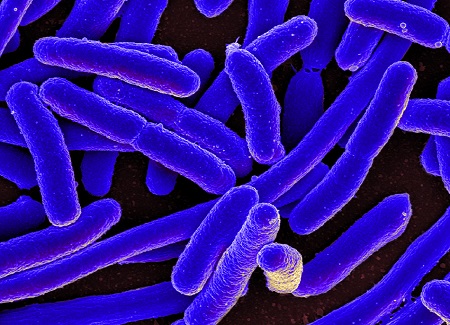
Meet Escherichia coli (E. coli for short).
E. coli is a bacterium that lives in the large intestine (or colon) of mammals and birds. E. coli cells are about 2 micrometers long, and from 0.25 to one micrometer across.
You might have heard about E. coli in the context of food poisoning. But most strains of this bacterium are harmless. Right now, you harbor about 30 trillion E. coli cells inside of you. They’re a normal and healthy part of what’s called our intestinal flora: the community of organisms that live inside our guts.
E. coli is one of the most studied and best-understood organisms on Earth. In what follows, we’ll be using E. coli to learn about the control of gene expression: essentially, how and when genes are turned on and off.
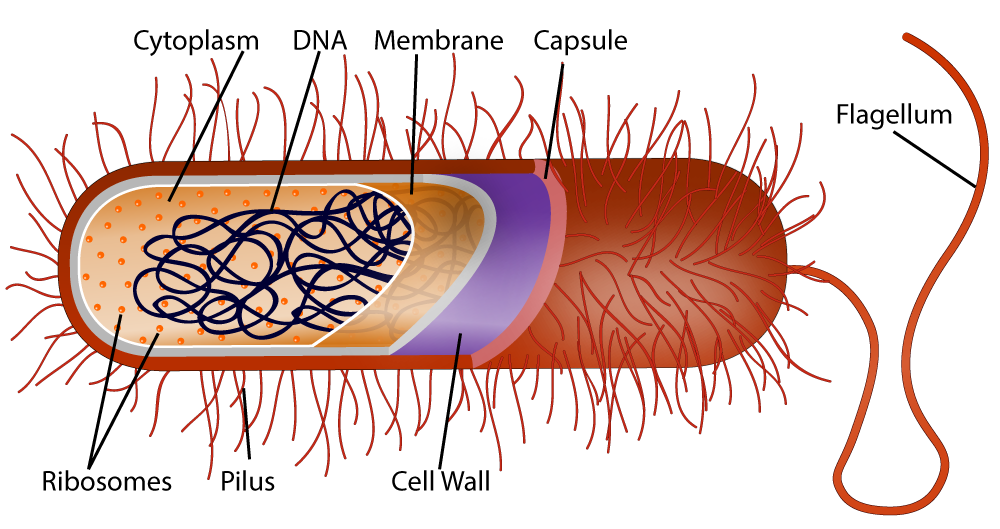
The genetic material of E. coli, like that of other bacteria, is organized into a single, looped chromosome. You can see this on the left in this illustration of a typical bacterial cell. What looks like a tangled strand of spaghetti is actually a single loop of DNA consisting of about 4.9 million base pairs. These 4.9 million base pairs make up E. coli’s genome: its complete set of genetic instructions.
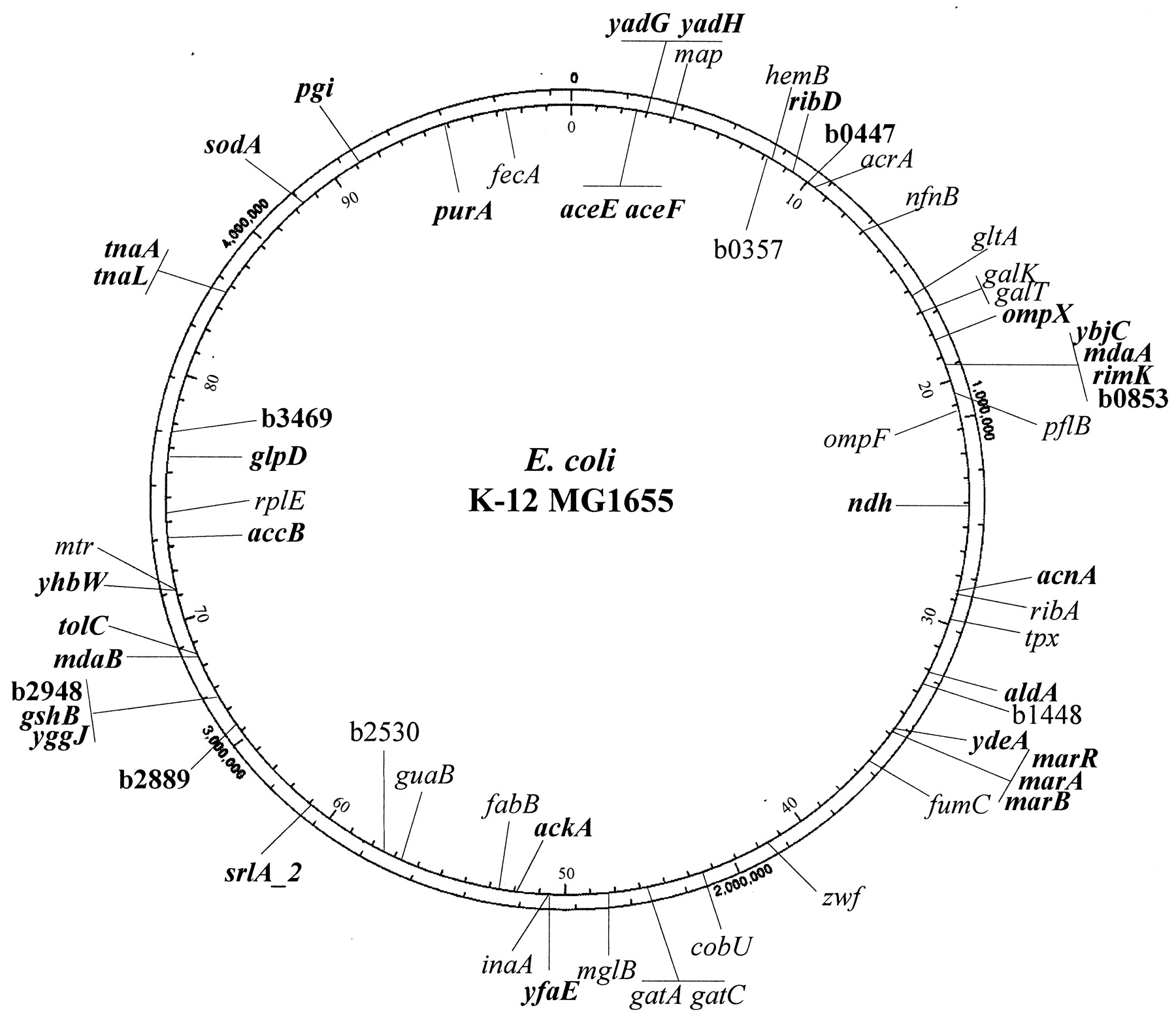
This looped chromosome is often represented as a circular chromosome map, like the one shown on the right.
“K-12 MG1655” is the specific strain of E. coli for which this map was made. Each four-letter abbreviation represents a different gene: a sequence of DNA that codes for a specific protein. Note that this map shows only a small number of E. coli genes: the full number is about 4500.
A small number of E. coli’s genes are for proteins that are constantly in use, and consequently, need to be continually transcribed. But most genes are for proteins that are only useful under certain conditions.

For example, E. coli possesses a group of enzymes that it uses to digest the disaccharide lactose (the sugar in milk). If E. coli is in a lactose-rich environment, expressing the genes for lactose-digesting enzymes will enable it to convert lactose into monosaccharides that can be further broken down during cellular respiration. But if there’s no lactose, then producing the enzymes for lactose digestion would be a waste of energy. So, it’s of adaptive value for E. coli to be able to control its production of these enzymes to match the availability of lactose in the environment. This is true for thousands of other genes as well.
How does E. coli do this? In what follows, we’ll look at the control of gene expression in prokaryotes through the control of transcription. Note that eukaryotes use different systems, which we’ll look at in the next few tutorials on this topic.
2. Operons: Description and Definition
Many of E. coli’s genes (as well as many genes in other bacteria, archaea, viruses, and, more rarely, eukaryotic organisms) are organized into systems called operons. Operons consist of the following components.

The DNA at 1 consists of regulatory genes. These control the expression of structural genes (4), which code for enzymes or other gene products. The regulatory gene produces a regulatory protein that determines whether or not the structural genes will be transcribed into mRNA and subsequently translated into protein. Because the regulatory protein often has the effect of preventing transcription, the regulatory protein is often referred to as a repressor.
Transcription is carried out by RNA polymerase (not shown above), which can only transcribe a gene by binding to a region of DNA called the promoter, shown above at “2.” Just downstream of the promoter is a region called the operator (3). The operator is a binding site for the regulatory protein/repressor that the regulatory gene codes for. Pulling this together, we can define an operon as follows (modified from Wikipedia):
…a cluster of genes under the control of a single promoter. The genes are transcribed and regulated in such a way that these genes are either expressed together or not at all.
This will become clearer by looking at an operon in action. We’ll start with the lac operon, the first operon whose function was understood. This understanding came about through the work of François Jacob, André Michel Lwoff, and Jacques Monod, who received the Nobel Prize for their work in 1965.
3. The lac Operon
The lac operon is a cluster of genes that code for a series of enzymes that work together to digest lactose into two monosaccharides: glucose and galactose. Here’s how the expression of these structural genes is controlled.
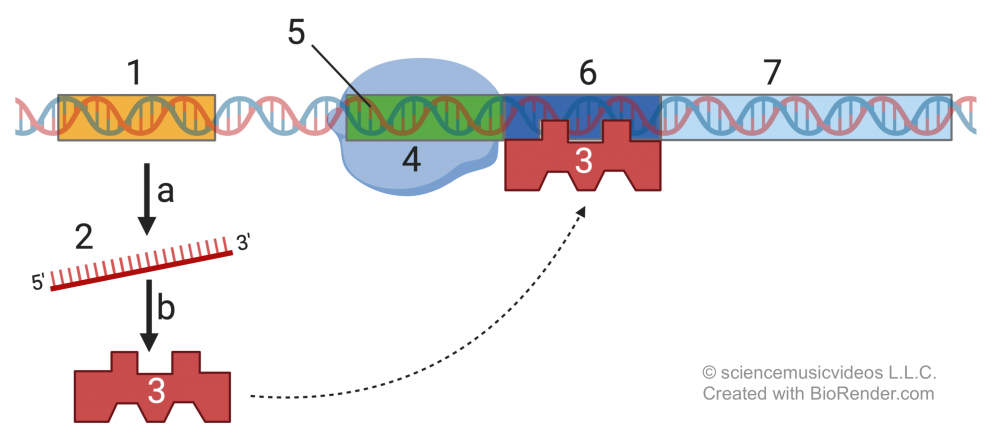
The DNA at “1” is the regulatory gene. This gene is transcribed (process “a”) into mRNA (2), which in turn is translated (process “b”) into a regulatory protein (3).
The regulatory protein (also known as a repressor) has two binding sites. In the absence of lactose, one of its binding sites is complementary to the operator region (6) of the lac operon. When the regulatory protein binds to the operator, RNA polymerase (shown at 4 bound to its promoter at 5) is blocked from transcribing the structural genes (7).
Think of this as an adaptation: when lactose is absent, the operon turns off transcription of the genes for enzymes that digest lactose.
Below, you can see how the situation changes when lactose is in the environment.
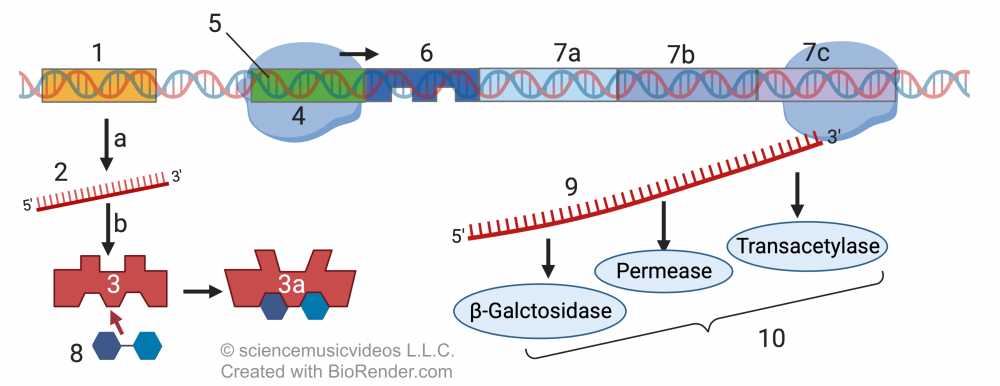
Lactose (8) will bind with the regulatory protein in a way that causes an allosteric shift so that the regulatory protein’s DNA binding site is no longer complementary to the lac operon’s operator (6). As a result, RNA polymerase (4), after binding to its promoter (5) can transcribe the structural genes (7a, 7b, and 7c) into mRNA (9), which can, in turn, be translated into the enzymatic proteins that digest lactose.
4. lac Operon: Labeled Diagrams
Label the interactive diagrams below.
[qwiz qrecord_id=”sciencemusicvideosMeister1961-Lac Operon, labeled diagrams (v2.0)”]
[h]Lac Operon: Interactive Diagrams
[i] Biohaiku
Operon System
Controls expression of genes
Such efficiency!
[q labels = “top”]
[l]operator
[fx] No. Please try again.
[f*] Correct!
[l]promoter
[fx] No, that’s not correct. Please try again.
[f*] Good!
[l]regulatory gene
[fx] No. Please try again.
[f*] Great!
[l]regulatory mRNA
[fx] No. Please try again.
[f*] Correct!
[l]regulatory protein
[fx] No, that’s not correct. Please try again.
[f*] Good!
[l]RNA polymerase
[fx] No. Please try again.
[f*] Correct!
[l]structural genes
[fx] No. Please try again.
[f*] Excellent!
[q labels = “top”]
[l]operator
[fx] No. Please try again.
[f*] Good!
[l]promoter
[fx] No, that’s not correct. Please try again.
[f*] Good!
[l]regulatory gene
[fx] No. Please try again.
[f*] Excellent!
[l]regulatory mRNA
[fx] No, that’s not correct. Please try again.
[f*] Excellent!
[l]regulatory protein
[fx] No, that’s not correct. Please try again.
[f*] Excellent!
[l]RNA polymerase
[fx] No. Please try again.
[f*] Excellent!
[l]structural genes
[fx] No, that’s not correct. Please try again.
[f*] Great!
[l]lactose
[fx] No. Please try again.
[f*] Correct!
[l]lactose-digesting enzymes
[fx] No, that’s not correct. Please try again.
[f*] Great!
[l]mRNA for lactose-digesting enzymes
[fx] No. Please try again.
[f*] Excellent!
[x][restart]
[/qwiz]
5. The lac operon and diauxic growth curves
Now that you understand the lac operon, you can understand a two-phase growth pattern that occurs when microbes are provided with two food sources, one of which is easier to metabolize than the other. This pattern is called diauxic growth.
The diagram below shows how this occurs when E. coli is grown in a culture with two food sources: glucose and lactose. From time 0 to hour 4, the population grows rapidly. Then, at point “a” growth slows down and enters a lag phase, indicated by the bracket at “b.” At point “c,” rapid growth resumes, and it continues until another lag phase is reached at “d.” If there’s plenty of food available between time 0 and point “d,” why does growth slow down at “b?”
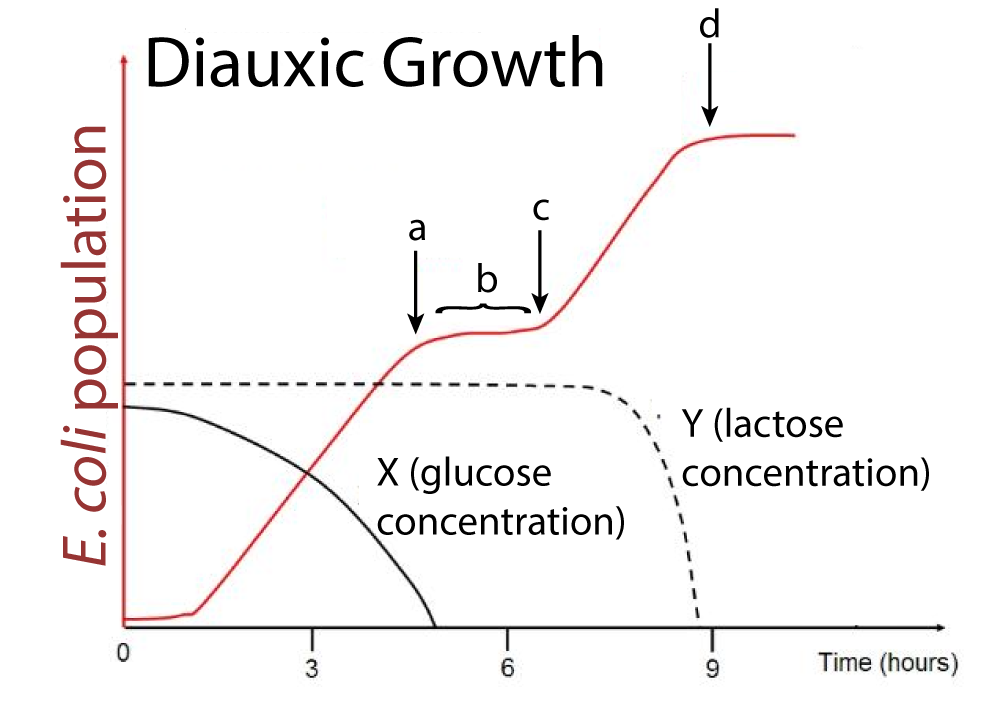
It’s all about operons. During the 1st growth phase, the bacteria are consuming glucose, but not lactose. How can you tell? Because the glucose concentration (X) is going down, while the lactose concentration (Y) stays constant.
Why is glucose consumed first? There’s a regulatory system that’s behind this (see the advanced topic below), but for the purposes of an AP Biology course, we can focus on the fact that glucose, as a monosaccharide, is easier to digest. With no modification, it can be fed directly into glycolysis and the subsequent reactions of cellular respiration. Consequently its adaptive for E. coli to be able to “choose” the simpler substance, which is glucose. Lactose, by contract, requires production of an enzyme to hydrolyze it down to monosaccharides, which can later be metabolized.
Consequently, only when the glucose is used up (at point “a”) will the lac operon get turned “on.” However, it takes some time (the lag phase at “b”) to generate enough lactose-digesting enzymes for the bacteria to start digesting the lactose, giving them the energy and matter they need to resume growth. Once those enzymes are produced (point “c”), growth can resume, and it continues until all of the lactose is consumed, causing another lag in growth (at “d.”).
6. The trp Operon
An organism’s metabolic activities can be divided into categories: breaking things down (often to release energy, as in cellular respiration) and building things up. The lac operon is in the first category: it produces enzymes for the breakdown of the disaccharide lactose into the two monosaccharides; glucose and galactose, which can be used as an energy source to power cellular respiration.
The trp operon is in the second category: it’s a system for controlling the synthesis of tryptophan, one of the 20 amino acids that make up proteins.
Because the trp operon involves synthesis, the logic behind its control is the opposite of that involved in the lac operon. For the trp operon, the logic is as follows: if tryptophan is lacking in the environment, then the operon system should be turned on so that the cell can synthesize the tryptophan it needs. On the other hand, if tryptophan is available, then the operon should be turned off: instead of wasting energy and matter making tryptophan, the cell should simply let tryptophan diffuse in, and use it for whatever protein it’s synthesizing.
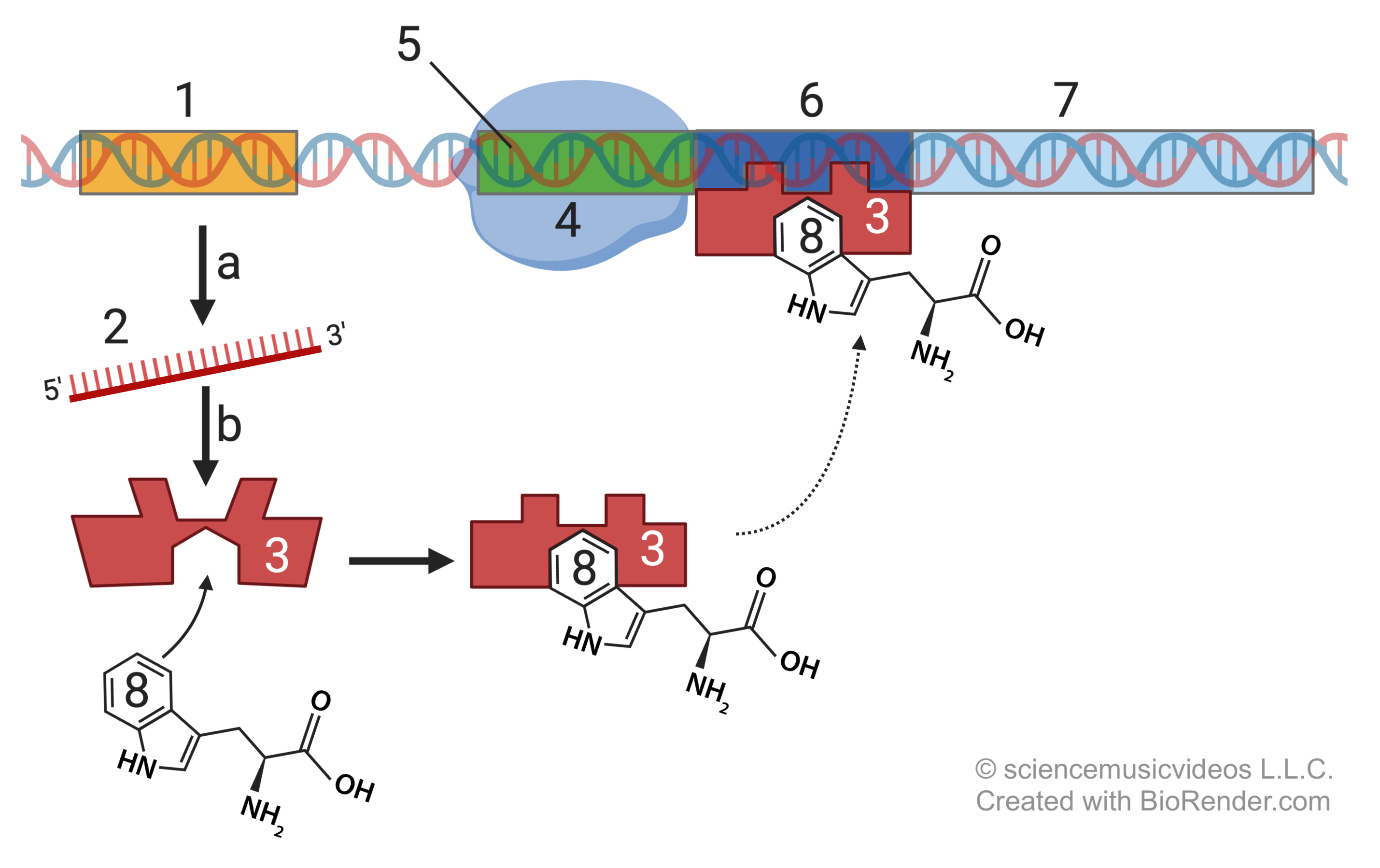
We’ll start with what happens when tryptophan is in E. coli’s environment (and thus diffusing into the cell). Based on what you know about the lac operon, you should be able to figure out why, in this situation, the structural genes are not transcribed.
Here’s what’s happening. The regulatory gene (1) produces regulatory mRNA (2), which gets translated into a regulatory protein (3).
This regulatory protein has two binding sites. If tryptophan is present in the environment, it will bind with the regulatory protein, which causes a change in the regulatory protein’s DNA binding site. In this case, the conformational change is such that the regulatory protein can bind with the operator (6). With the operator occupied, RNA polymerase (4) can’t move past the promoter (5), and can’t transcribe the structural genes (7).
In operons, the regulatory protein is often referred to as a repressor. That’s because this protein binds with the operator, blocking transcription. In the case of the trp operon, because the regulatory protein only binds to the operator when tryptophan is present, tryptophan is often referred to as a co-repressor.
If tryptophan is not present in the environment, the situation changes as shown below.
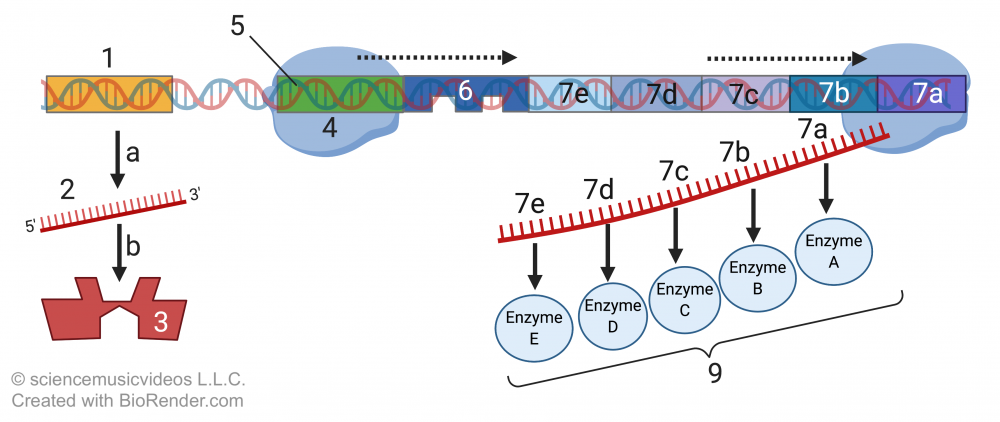
Without tryptophan, the regulatory protein (3) can’t bind with the operator (6). RNA polymerase (4) is free to bind with the operon’s promoter (5) and transcribe the structural genes (7A through 7E), producing the structural mRNA (8A through 8E) that will be translated into the structural proteins (9A through 9E) that constitute the pathway for synthesizing tryptophan.
7. trp operon labeled diagrams
[qwiz qrecord_id=”sciencemusicvideosMeister1961-trp Operon Labeled Diagram (v2.0)”]
[h]Trp operon: Labeled Diagrams
[i]
[q labels = “top”]
[l]enzymes for tryptophan synthesis
[fx] No, that’s not correct. Please try again.
[f*] Correct!
[l]mRNA for structural genes
[fx] No. Please try again.
[f*] Good!
[l]operator
[fx] No. Please try again.
[f*] Good!
[l]promoter
[fx] No. Please try again.
[f*] Great!
[l]regulatory gene
[fx] No. Please try again.
[f*] Good!
[l]regulatory protein
[fx] No. Please try again.
[f*] Good!
[l]mRNA for regulatory protein
[fx] No, that’s not correct. Please try again.
[f*] Good!
[l]RNA polymerase
[fx] No. Please try again.
[f*] Good!
[l]structural genes
[fx] No. Please try again.
[f*] Good!
[q labels = “top”]
[l]operator
[fx] No, that’s not correct. Please try again.
[f*] Good!
[l]promoter
[fx] No, that’s not correct. Please try again.
[f*] Correct!
[l]regulatory gene
[fx] No. Please try again.
[f*] Correct!
[l]regulatory gene’s mRNA
[fx] No. Please try again.
[f*] Great!
[l]regulatory protein
[fx] No. Please try again.
[f*] Good!
[l]RNA polymerase
[fx] No, that’s not correct. Please try again.
[f*] Good!
[l]structural genes
[fx] No. Please try again.
[f*] Excellent!
[l]tryptophan
[fx] No. Please try again.
[f*] Good!
[/qwiz]
8. Operons can be inducible or repressible
Now that we’ve looked at both the lac and trp operons, we introduce two terms related to how each operon functions. Operons like the lac operon are described as being inducible. To “induce” means to get someone or something to do something. The lac operon is considered to be inducible because its default condition is “off” with the repressor bound to the operator, blocking transcription. Lactose, which can be described as the inducer, turns the operon “on.”
By contrast, the trp operon is a repressible operon. Its default condition is “on.” When tryptophan enters the environment, the operon is turned “off,” which means that it stops producing enzymes that synthesize tryptophan.
Study the diagrams below, and see if you can explain to yourself why these names — inducible vs. repressible— make sense.
 |
 |
| The lac operon: an example of an inducible operon | The trp operon: an example of a repressible operon. |
9. Operons Flashcards
[qdeck style=”width: 600px !important; min-height: 450px !important;” flip_direction=”random” bold_text=”false” qrecord_id=”sciencemusicvideosMeister1961-Operons Flashcards (v2.0)”]
[h] Operons Flashcards
[q json=”true” yy=”4″ unit=”6.Gene_Expression_and_Regulation” dataset_id=”AP_Bio_Flashcards_2022|18658f7e1c110″ question_number=”232″ topic=”6.5.Regulation_of_Gene_Expression”] What is a promoter?
[a] A promoter is a DNA sequence where RNA polymerase (RNAP) can bind to initiate transcription. The promoter is always upstream from the gene.
[q json=”true” yy=”4″ unit=”6.Gene_Expression_and_Regulation” dataset_id=”AP_Bio_Flashcards_2022|185bf4cd0f910″ question_number=”234″ topic=”6.5.Regulation_of_Gene_Expression”] What’s an operon?
[a] An operon is a group of genes transcribed in a single mRNA molecule, which can then be translated into multiple proteins, all of which are part of the same metabolic pathway or process. Operons generally involve a regulatory system in which the expression of the operon is under the control of a regulatory protein that interacts with an operator region near the operon’s promoter (the details of which are covered in several other cards).
[q json=”true” yy=”4″ unit=”6.Gene_Expression_and_Regulation” dataset_id=”AP_Bio_Flashcards_2022|1853a962b3510″ question_number=”235″ topic=”6.5.Regulation_of_Gene_Expression”] Explain the difference between an inducible operon (like the lac operon) and a repressible operon (like the trp operon)
[a] Inducible operons are turned “on” (induced) by the presence of a metabolite. For example, the lac operon is induced by the presence of lactose, which turns the operon “on.” When all the lactose is digested, the operon switches off (and no longer produces enzymes for lactose digestion).
Repressible operons are turned “off” (repressed) by the presence of a metabolite. For example, when there’s no tryptophan in the environment, the trp operon turns “on,” and the cell produces enzymes needed for tryptophan synthesis. When tryptophan is present it represses the operon.
[q json=”true” yy=”4″ unit=”6.Gene_Expression_and_Regulation” dataset_id=”AP_Bio_Flashcards_2022|1843f21270510″ question_number=”236″ topic=”6.5.Regulation_of_Gene_Expression”] Explain how the lac operon works when lactose is absent from E. coli’s environment.
[a] The lac operon is an inducible operon, consisting of a regulatory gene (1), a promoter (5), an operator (6), and structural genes (7). The structural genes code for enzymes that digest lactose into monosaccharides. When lactose is absent, the regulatory protein (3) binds to the operator region (6), which blocks RNA polymerase (4), preventing it from transcribing the structural genes (7).
[q json=”true” yy=”4″ unit=”6.Gene_Expression_and_Regulation” topic=”6.5.Regulation_of_Gene_Expression” dataset_id=”AP_Bio_Flashcards_2022|a0586d636189″ question_number=”237″] Explain how the lac operon works when lactose is present in E. coli’s environment.
[a] When lactose (8) is present in the cell’s environment, it diffuses into the cell and binds with the lac regulatory protein (3). Binding causes an allosteric change in the protein (3a), making it unable to bind with the operator region (6). With the operator unblocked, RNA polymerase can transcribe the genes for lactose digestion (7a – 7c).
[q json=”true” yy=”4″ unit=”6.Gene_Expression_and_Regulation” dataset_id=”AP_Bio_Flashcards_2022|183ac7239e910″ question_number=”238″ topic=”6.5.Regulation_of_Gene_Expression”] Explain how the trp operon works when the amino acid tryptophan is not present in E. coli’s environment.
[a] The trp operon is repressible, consisting of a regulatory gene (1), a promoter (5), an operator (6), and structural genes (7a – 7e), which produce enzymes that synthesize the amino acid tryptophan. When tryptophan is absent, the regulatory protein cannot bind with the operator. Because the operator isn’t blocked, RNA polymerase (4), can transcribe the structural genes.
[q json=”true” yy=”4″ unit=”6.Gene_Expression_and_Regulation” topic=”6.5.Regulation_of_Gene_Expression” dataset_id=”AP_Bio_Flashcards_2022|9eb300fb2d89″ question_number=”239″] Explain how the trp operon works when the amino acid tryptophan is available in E. coli’s environment.
[a] When tryptophan (8) is available in the cell’s environment, it diffuses into the cell and binds with the trp regulatory protein (3). This causes an allosteric change in the trp regulator so that it binds with the operator region (6), blocking RNA polymerase from transcribing the genes for tryptophan synthesis.
[q json=”true” yy=”4″ unit=”6.Gene_Expression_and_Regulation” topic=”6.5.Regulation_of_Gene_Expression” dataset_id=”AP_Bio_Flashcards_2022|9dabe7bb8989″ question_number=”240″] The lac operon system works through negative feedback. Explain.
[a] The lac operon system is an inducible operon. When lactose is present it binds with the regulatory protein, causing an allosteric shift that keeps that protein from binding with the operator, permitting transcription to occur. When all the lactose is digested, the regulatory protein reverts to its unbound shape, enabling it to bind with the operator again, blocking transcription. Thus, the entire system is a negative feedback system in which the activity of the system has the effect of turning the system off.
[q]Connect how operons work to the phenomenon of diauxic growth.
[a]During the 1st growth phase, the bacteria are consuming the easier-to-digest glucose, but not lactose. The evidence for this is that the glucose concentration (X) is going down, while the lactose concentration (Y) stays constant. When the glucose is used up (at point “a”) the lac operon gets turned “on.” Because it takes some time to generate enough lactose-digesting enzymes for the bacteria to have enough energy and matter to resume growth, there’s a lag phase (at “b”) Once those enzymes are produced (point “c”), growth can resume, and it continues until all of the lactose is consumed, causing another lag in growth (at “d.”).
[/qdeck]
10. Operons Quiz
This quiz uses diagrams and multiple-choice questions to test your understanding of operons.
[qwiz style=”width: 600px !important; min-height: 450px !important;” random=”true” qrecord_id=”sciencemusicvideosMeister1961-Operons Quiz (v2.0)”]
[h] Operons
[i] Operons Biohaiku
An operator
When blocked by a repressor
Prevents transcription
[q json=”true” dataset_id=”Operons|1d4690ab006f00″ question_number=”1″] Which number is the regulatory gene?
[textentry single_char=”true”]
[c]ID E=[Qq]
[f]IFllcy4g4oCcMeKAnSBpcyB0aGUgcmVndWxhdG9yecKgZ2VuZS4=[Qq]
[c]ICo=[Qq]
[f]IE5vLiBIZXJlJiM4MjE3O3MgYSBoaW50LiBUaGUgcmVndWxhdG9yeSBnZW5lIGNvZGVzIGZvciBhIHJlZ3VsYXRvcnkgcHJvdGVpbiwgd2hpY2ggY2FuLCBpbiB0dXJuLCBiaW5kIHdpdGggYSByZWdpb24gb24gdGhlIEROQSBjYWxsZWQgYW4gb3BlcmF0b3IuIFNvLCBmaW5kIHNvbWV0aGluZyB0aGF0IHJlcHJlc2VudHMgc29tZXRoaW5nIHRoYXQgY291bGQgYmluZCB3aXRoIHRoZSBETkEsIHRoZW4gdXNlIHRoZSBhcnJvd3MgaW4gdGhlIGRpYWdyYW0gdG8gZmluZCB0aGUgRE5BIHRoYXQgY29kZXMgZm9yIHRoYXQgaXQu
Cg==[Qq]
[q json=”true” dataset_id=”Operons|1d463f2d604300″ question_number=”2″] Which number is the regulatory mRNA?
[textentry single_char=”true”]
[c]ID I=[Qq]
[f]IFllcy4g4oCcMuKAnSBpcyB0aGUgcmVndWxhdG9yeSBtUk5BLg==[Qq]
[c]ICo=[Qq]
[f]IE5vLiBIZXJlJiM4MjE3O3MgYSBoaW50LiBSZW1lbWJlciB0aGUgY2VudHJhbCBkb2dtYSB0aGF0IEROQSBtYWtlcyBSTkEgbWFrZXMgcHJvdGVpbi4gWW91IGNhbiBzZWUgdGhpcyBwcm9jZXNzIHJlcHJlc2VudGVkIG9uIHRoZSBsZWZ0IHNpZGUgb2YgdGhlIGRpYWdyYW0uIEluIHRlcm1zIG9mIHRoaXMgcXVlc3Rpb24sIHJlbWVtYmVyIHRoYXQgdGhlIHJlZ3VsYXRvcnkgbVJOQSBjb2RlcyBmb3IgYSByZWd1bGF0b3J5IHByb3RlaW4sIHdoaWNoIGNhbiwgaW4gdHVybiwgYmluZCB3aXRoIGEgcmVnaW9uIG9uIHRoZSBETkEgY2FsbGVkIGFuIG9wZXJhdG9yLiBTbywgZmluZCBzb21ldGhpbmcgdGhhdCByZXByZXNlbnRzIHNvbWV0aGluZyB0aGF0IGNvdWxkIGJpbmQgd2l0aCB0aGUgRE5BLCB0aGVuIHVzZSB0aGUgYXJyb3dzIGluIHRoZSBkaWFncmFtIHRvIGZpbmQgdGhlIG1STkEgdGhhdCBjb2RlcyBmb3IgaXQu
Cg==[Qq]
[q json=”true” dataset_id=”Operons|1d45eb5bb43300″ question_number=”3″] Which number is the regulatory protein?
[textentry single_char=”true”]
[c]ID M=[Qq]
[f]IFllcy4g4oCcM+KAnSBpcyB0aGUgcmVndWxhdG9yeSBwcm90ZWluLg==[Qq]
[c]ICo=[Qq]
[f]IE5vLiBIZXJlJiM4MjE3O3MgYSBoaW50LiBSZW1lbWJlciB0aGUgY2VudHJhbCBkb2dtYSB0aGF0IEROQSBtYWtlcyBSTkEgbWFrZXMgcHJvdGVpbi4gWW91IGNhbiBzZWUgdGhpcyBwcm9jZXNzIHJlcHJlc2VudGVkIG9uIHRoZSBsZWZ0IHNpZGUgb2YgdGhlIGRpYWdyYW0uIFRoZSBwcm90ZWluIHdvdWxkIGJlIGF0IHRoZSBlbmQgb2YgdGhpcyBjaGFpbiBvZiBldmVudHMuIEluIGFkZGl0aW9uLCB0aGlzIHByb3RlaW4gY2FuIGJpbmQgd2l0aCB0aGUgRE5BIGF0IGEgcmVnaW9uIGNhbGxlZCB0aGUgb3BlcmF0b3IuIFVzZSB0aGVzZSBjbHVlcyB0byBmaW5kIHRoZSBhbnN3ZXIgbmV4dCB0aW1lLg==
Cg==[Qq]
[q json=”true” dataset_id=”Operons|1d45a32e439700″ question_number=”4″] Which number is RNA polymerase?
[textentry single_char=”true”]
[c]ID Q=[Qq]
[f]IFllcy4g4oCcNOKAnSBpcyBSTkEgcG9seW1lcmFzZS4=[Qq]
[c]ICo=[Qq]
[f]IE5vLiBIZXJlJiM4MjE3O3MgYSBoaW50LiBSTkEgcG9seW1lcmFzZSBpcyBhIHByb3RlaW4gdGhhdCB0cmFuc2NyaWJlcyBETkEgaW50byBtUk5BLiBJZiAmIzgyMjA7N2EmIzgyMjE7IHRocm91Z2ggJiM4MjIwOzdjJiM4MjIxOyByZXByZXNlbnQgdGhpcyBvcGVyb24mIzgyMTc7cyBzdHJ1Y3R1cmFsIGdlbmVzLCBhbmQgOSByZXByZXNlbnRzIG1STkEsIHdoYXQmIzgyMTc7cyB0aGUgb25seSB0aGluZyBpbiB0aGlzIGRpYWdyYW0gdGhhdCBjb3VsZCBiZSB0cmFuc2NyaWJpbmcgdGhlIGZvcm1lciBpbnRvIHRoZSBsYXR0ZXI/
Cg==[Qq]
[q json=”true” dataset_id=”Operons|1d455d54dedf00″ question_number=”5″] Which number is the promoter?
[textentry single_char=”true”]
[c]ID U=[Qq]
[f]IFllcy4g4oCcNeKAnSBpc8KgdGhlIHByb21vdGVyLg==[Qq]
[c]ICo=[Qq]
[f]IE5vLiBIZXJlJiM4MjE3O3MgYSBoaW50LsKgVGhlIHByb21vdGVyIGlzIHRoZSByZWdpb24gd2hlcmUgUk5BIHBvbHltZXJhc2UgYmluZHMgdG8gYmVnaW4gdHJhbnNjcmlwdGlvbiBvZiB0aGUgb3Blcm9uJiM4MjE3O3Mgc3RydWN0dXJhbCBnZW5lcy4gSWYgUk5BIHBvbHltZXJhc2UgaXMgJiM4MjIwOzQsJiM4MjIxOyB0aGVuIHdoYXQgaGFzIHRvIGJlIHRoZSBwcm9tb3Rlcj8=
Cg==[Qq]
[q json=”true” dataset_id=”Operons|1d4512d3625f00″ question_number=”6″] Which number is the operator?
[textentry single_char=”true”]
[c]ID Y=[Qq]
[f]IFllcy4g4oCcNuKAnSBpc8KgdGhlIG9wZXJhdG9yLg==[Qq]
[c]ICo=[Qq]
[f]IE5vLiBIZXJlJiM4MjE3O3MgYSBoaW50LiBUaGUgb3BlcmF0b3IgaXMganVzdCAmIzgyMjA7ZG93bnN0cmVhbSYjODIyMTsgb2YgdGhlIHByb21vdGVyIGFuZCBqdXN0ICYjODIyMDt1cHN0cmVhbSYjODIyMTsgb2YgdGhlIHN0cnVjdHVyYWwgZ2VuZXMuIElmIHRoZSBzdHJ1Y3R1cmFsIGdlbmVzIGFyZSBhdCA3YSB0aHJvdWdoIDdjLCBhbmQgdGhlIHByb21vdGVyIGlzIGF0ICYjODIyMDs0LCYjODIyMTsgdGhlbiB3aGljaCBudW1iZXIgaXMgcmVwcmVzZW50aW5nIHRoZSBvcGVyYXRvcj8=
Cg==[Qq]
[q json=”true” dataset_id=”Operons|1d44c851e5df00″ question_number=”7″ multiple_choice=”true”] Which of the following would represent one of the structural genes?
[c]IDE=[Qq]
[f]IE5vLiAmIzgyMjA7MSYjODIyMTsgcmVwcmVzZW50cyBhIHJlZ3VsYXRvcnkgZ2VuZS4=[Qq]
[c]IDU=[Qq]
[f]IE5vLiAmIzgyMjA7NSYjODIyMTsgcmVwcmVzZW50cyB0aGUgcHJvbW90ZXIu[Qq]
[c]IDY=[Qq]
[f]IE5vLiAmIzgyMjA7NiYjODIyMTsgcmVwcmVzZW50cyB0aGUgb3BlcmF0b3Iu[Qq]
[c]ID di[Qq]
[f]IFllcy4gJiM4MjIwOzdiJiM4MjIxOyBpcyBvbmUgb2YgdGhyZWUgc3RydWN0dXJhbCBnZW5lcyBpbiB0aGUgbGFjIG9wZXJvbi4gRWFjaCBvZiB0aGVzZSBnZW5lcyBnZXRzIHRyYW5zY3JpYmVkIGludG8gbVJOQSwgYW5kIHRoZW4gc3ludGhlc2l6ZWQgaW50byBvbmUgb2YgdGhlIHRocmVlIHByb3RlaW5zIHRoYXQgYnJlYWsgZG93biBsYWN0b3NlIGludG8gZ2x1Y29zZSBhbmQgZ2FsYWN0b3NlLg==
Cg==[Qq]
[q json=”true” dataset_id=”Operons|1d447dd0695f00″ question_number=”8″] Which number represents lactose?
[textentry single_char=”true”]
[c]ID g=[Qq]
[f]IFllcy4g4oCcOOKAnSBpcyBsYWN0b3NlLg==[Qq]
[c]ICo=[Qq]
[f]IE5vLiBIZXJlIGFyZSB0d28gaGludHMuIDEpIExhY3Rvc2UgaXMgYSBkaXNhY2NoYXJpZGUsIGEgc3VnYXIgbWFkZSBvZiB0d28gc2ltcGxlIHN1Z2FyIChtb25vc2FjY2hhcmlkZSkgc3VidW5pdHMuIFdoYXQgb24gdGhpcyBkaWFncmFtIGNvdWxkIGJlIG1hZGUgb2YgdHdvIHN1YnVuaXRzPyDCoDIpIExhY3Rvc2UgYmluZHMgd2l0aCB0aGUgcmVndWxhdG9yeSBwcm90ZWluLCB3aGljaCB0dXJucyB0aGUgb3Blcm9uICYjODIyMDtvZmYuJiM4MjIxOyBJZiAmIzgyMjA7MyYjODIyMTsgaXMgdGhlIHJlZ3VsYXRvcnkgcHJvdGVpbiwgdGhlbiB3aGF0IGNvdWxkIGJlIHNvbWV0aGluZyB0aGF0IGJpbmRzIHdpdGggdGhpcyBwcm90ZWluPw==
Cg==[Qq]
[q json=”true” dataset_id=”Operons|1d4435a2f8c300″ question_number=”9″] Which number represents the mRNA that’s transcribed from the structural genes in this operon?
[textentry single_char=”true”]
[c]ID k=[Qq]
[f]IFllcy4g4oCcOeKAnSBpcyB0aGUgbVJOQSB0aGF0IGNvZGVzIGZvciB0aGUgb3Blcm9uJiM4MjE3O3Mgc3RydWN0dXJhbCBnZW5lcy4=[Qq]
[c]ICo=[Qq]
[f]IE5vLiBIZXJlJiM4MjE3O3MgYSBoaW50LiBJZiB0aGUgdGhyZWUgYm94ZXMgYXQgMTAgcmVwcmVzZW50ZWQgdGhlIGdlbmUgcHJvZHVjdHMsIGFuZCB0aGUgdGhyZWUgZ2VuZXMgYXQgJiM4MjIwOzcmIzgyMjE7IHJlcHJlc2VudCB0aGUgc3RydWN0dXJhbCBnZW5lcywgdGhlbiB3aGF0IGhhcyB0byBiZSB0aGUgbVJOQSBmb3IgdGhlc2UgZ2VuZXM/
Cg==[Qq]
[q json=”true” dataset_id=”Operons|1d43eb217c4300″ question_number=”10″ multiple_choice=”true”] Which of the following would best describe the operon shown below?
[c]IGluZHVjaWJsZc KgIMKgIMKgIA==[Qq][c]IHJlcHJlc3NpYmxl
Cg==[Qq][f]IFllcy4gVGhlIG9wZXJvbiBzaG93biBhYm92ZSBpcyAmIzgyMjA7aW5kdWNpYmxlLiYjODIyMTsgVG8gJiM4MjIwO2luZHVjZSYjODIyMTsgaXMgdG8gY2F1c2Ugc29tZXRoaW5nIHRvIGhhcHBlbi4gVGhlIGxhYyBvcGVyb24gaXMgaW5kdWNpYmxlIGJlY2F1c2UgbGFjdG9zZSwgd2hlbiBwcmVzZW50LCB0dXJucyB0aGUgb3Blcm9uICYjODIyMDtvbi4mIzgyMjE7IFRoZSBkZWZhdWx0IGNvbmRpdGlvbiwgd2hlbiBsYWN0b3NlIGlzIGFic2VudCwgaXMgZm9yIHRoaXMgb3Blcm9uIHN5c3RlbSB0byBiZSB0dXJuZWQgJiM4MjIwO29mZi4mIzgyMjE7[Qq]
[f]IE5vLiBUaGUgb3Blcm9uIHNob3duIGFib3ZlIGlzICYjODIyMDtpbmR1Y2libGUuJiM4MjIxOyBUbyAmIzgyMjA7aW5kdWNlJiM4MjIxOyBpcyB0byBjYXVzZSBzb21ldGhpbmcgdG8gaGFwcGVuLiBUaGUgbGFjIG9wZXJvbiBpcyBpbmR1Y2libGUgYmVjYXVzZSBsYWN0b3NlLCB3aGVuIHByZXNlbnQsIHR1cm5zIHRoZSBvcGVyb24gJiM4MjIwO29uLiYjODIyMTsgVGhlIGRlZmF1bHQgY29uZGl0aW9uLCB3aGVuIGxhY3Rvc2UgaXMgYWJzZW50LCBpcyBmb3IgdGhpcyBvcGVyb24gc3lzdGVtIHRvIGJlIHR1cm5lZCAmIzgyMjA7b2ZmLiYjODIyMTs=
Cg==[Qq]
[q json=”true” dataset_id=”Operons|1d439e4bf3df00″ question_number=”11″ multiple_choice=”true”] The diagram below represents the lac operon. Which statement about the diagram below is most correct?
[c]IFRoZSBzdHJ1Y3R1cmFsIGdlbmVzIGFyZSBiZWluZyB0cmFuc2NyaWJlZCBpbnRvIGEgcHJvdGVpbiwgYXMgaXMgc2hvd24gYXQgJiM4MjIwOzEsJiM4MjIxOyAmIzgyMjA7MiwmIzgyMjE7IGFuZCAmIzgyMjA7My4mIzgyMjE7[Qq]
[f]IE5vLiBXaGF0JiM4MjE3O3Mgc2hvd24gYXQgJiM4MjIwOzEsJiM4MjIxOyAmIzgyMjA7MiwmIzgyMjE7IGFuZCAmIzgyMjA7MyYjODIyMTsgYXJlIHRoZSByZWd1bGF0b3J5IGdlbmUsIHRoZSBtUk5BIHRyYW5zY3JpYmVkIGZyb20gdGhpcyBnZW5lLCBhbmQgdGhlIHJlZ3VsYXRvcnkgcHJvdGVpbi4gVGhlIHN0cnVjdHVyYWwgZ2VuZXMgKGF0ICYjODIyMDs3JiM4MjIxOykgYXJlIGJsb2NrZWQgYmVjYXVzZSB0aGUgcmVndWxhdG9yeSBwcm90ZWluICgzKSBpcyBib3VuZCB0byB0aGUgb3BlcmF0b3IgKDYpLg==[Qq]
[c]IFRoZSBzdHJ1Y3R1cmFsIGdlbmVzIGFyZSBub3QgYmVpbmcgZXhwcmVzc2Vk IGJlY2F1c2UgbGFjdG9zZSBpcyBub3QgaW4gdGhlIGVudmlyb25tZW50Lg==[Qq]
[f]IFllcy4gQmVjYXVzZSBsYWN0b3NlIGlzIG5vdCBpbiB0aGUgZW52aXJvbm1lbnQsIHRoZSByZWd1bGF0b3J5IHByb3RlaW4gKDMpIGhhcyBhIGNvbmZvcm1hdGlvbiB0aGF0IGVuYWJsZXMgaXQgdG8gYmluZCB3aXRoIHRoZSBvcGVyYXRvciAoNiksIHByZXZlbnRpbmcgUk5BIHBvbHltZXJhc2UgZnJvbSB0cmFuc2NyaWJpbmcgdGhlIHN0cnVjdHVyYWwgZ2VuZXMu[Qq]
[c]IFRoZSBzdHJ1Y3R1cmFsIGdlbmVzIGFyZSBub3QgYmVpbmcgZXhwcmVzc2VkLCBiZWNhdXNlIFJOQSBwb2x5bWVyYXNlIGlzIGJsb2NraW5nIHRoZSByZWd1bGF0b3J5IHByb3RlaW4gZnJvbSB0cmFuc2NyaWJpbmcgdGhlIGdlbmVzLg==[Qq]
[f]IE5vIChidXQgeW91IGhhdmUgdGhlIHJpZ2h0IGlkZWEpLiBCZWNhdXNlIGxhY3Rvc2UgaXMgbm90IGluIHRoZSBlbnZpcm9ubWVudCwgdGhlIHJlZ3VsYXRvcnkgcHJvdGVpbiAoMykgaGFzIGEgY29uZm9ybWF0aW9uIHRoYXQgZW5hYmxlcyBpdCB0byBiaW5kIHdpdGggdGhlIG9wZXJhdG9yICg2KSwgcHJldmVudGluZyBSTkEgcG9seW1lcmFzZSBmcm9tIHRyYW5zY3JpYmluZyB0aGUgc3RydWN0dXJhbCBnZW5lcy4=
Cg==[Qq]
[q json=”true” dataset_id=”Operons|1d42769a0dc300″ question_number=”15″] Which number represents the substrate of the enzymes produced by this operon?
[textentry single_char=”true”]
[c]ID g=[Qq]
[f]IFllcy4g4oCcOOKAnSBpcyBsYWN0b3NlLCB3aGljaCBpcyB0aGUgc3Vic3RyYXRlIG9mIHRoZSBlbnp5bWVzIHRoYXQgdGhpcyBvcGVyb24gcHJvZHVjZXMu[Qq]
[c]ICo=[Qq]
[f]IE5vLiBIZXJlJiM4MjE3O3MgYcKgaGludC7CoFRoZSBzdWJzdHJhdGUgb2YgdGhlIGVuenltZXMgcHJvZHVjZWQgYnkgdGhpcyBvcGVyb24gaXMgdGhlIHNhbWUgbW9sZWN1bGUgd2hvc2UgcHJlc2VuY2UgdHVybnMgdGhlIG9wZXJvbiAmIzgyMjA7b24uJiM4MjIxOyBXaGljaCBtb2xlY3VsZSBiaW5kcyB3aXRoIHRoZSByZWd1bGF0b3J5IHByb3RlaW4gKHNob3duIGF0ICYjODIyMDszJiM4MjQyOykgaW4gYSB3YXkgdGhhdCBjaGFuZ2VzIHRoYXQgcHJvdGVpbiYjODIxNztzIHNoYXBlLCBrZWVwaW5nIGl0IGZyb20gYmluZGluZyB3aXRoIHRoZSBvcGVyYXRvcj8=
Cg==[Qq]
[q json=”true” dataset_id=”Operons|1d41e63f2c8b00″ question_number=”17″] The diagram below represents the trp operon. Which number is the regulatory mRNA?
[textentry single_char=”true”]
[c]ID I=[Qq]
[f]IFllcy4g4oCcMuKAnSBpcyB0aGUgcmVndWxhdG9yeSBtUk5BLg==[Qq]
[c]ICo=[Qq]
[f]IE5vLiBIZXJlJiM4MjE3O3MgYSBoaW50LiBSZW1lbWJlciB0aGUgY2VudHJhbCBkb2dtYSB0aGF0IEROQSBtYWtlcyBSTkEgbWFrZXMgcHJvdGVpbi4gWW91IGNhbiBzZWUgdGhpcyBwcm9jZXNzIHJlcHJlc2VudGVkIG9uIHRoZSBsZWZ0IHNpZGUgb2YgdGhlIGRpYWdyYW0uIEluIHRlcm1zIG9mIHRoaXMgcXVlc3Rpb24sIHJlbWVtYmVyIHRoYXQgdGhlIHJlZ3VsYXRvcnkgbVJOQSBjb2RlcyBmb3IgYSByZWd1bGF0b3J5IHByb3RlaW4sIHdoaWNoIGNhbiwgaW4gdHVybiwgYmluZCB3aXRoIGEgcmVnaW9uIG9uIHRoZSBETkEgY2FsbGVkIGFuIG9wZXJhdG9yLiBTbywgZmluZCBzb21ldGhpbmcgdGhhdCByZXByZXNlbnRzIHNvbWV0aGluZyB0aGF0IGNvdWxkIGJpbmQgd2l0aCB0aGUgRE5BLCB0aGVuIHVzZSB0aGUgYXJyb3dzIGluIHRoZSBkaWFncmFtIHRvIGZpbmQgdGhlIG1STkEgdGhhdCBjb2RlcyBmb3IgaXQu[Qq]
[q json=”true” dataset_id=”Operons|1d40b094ff1700″ question_number=”21″] The diagram below represents the trp operon. Which number is the operator?
[textentry single_char=”true”]
[c]ID Y=[Qq]
[f]IFllcy4g4oCcNuKAnSBpc8KgdGhlIG9wZXJhdG9yLg==[Qq]
[c]ICo=[Qq]
[f]IE5vLiBIZXJlJiM4MjE3O3MgYSBoaW50LiBUaGUgb3BlcmF0b3IgaXMganVzdCAmIzgyMjA7ZG93bnN0cmVhbSYjODIyMTsgb2YgdGhlIHByb21vdGVyIGFuZCBqdXN0ICYjODIyMDt1cHN0cmVhbSYjODIyMTsgb2YgdGhlIHN0cnVjdHVyYWwgZ2VuZXMuIElmIHRoZSBzdHJ1Y3R1cmFsIGdlbmVzIGFyZSBhdCA3LCBhbmQgdGhlIHByb21vdGVyIGlzIGF0ICYjODIyMDs0LCYjODIyMTsgdGhlbiB3aGljaCBudW1iZXIgaXMgcmVwcmVzZW50aW5nIHRoZSBvcGVyYXRvcj8=
Cg==[Qq]
[q json=”true” dataset_id=”Operons|1d4016e9ee4f00″ question_number=”23″] The diagram below represents the trp operon. Which number represents tryptophan?
[textentry single_char=”true”]
[c]ID g=[Qq]
[f]IFllcy4g4oCcOOKAnSBpcyB0cnlwdG9waGFuLg==[Qq]
[c]ICo=[Qq]
[f]IE5vLiBIZXJlJiM4MjE3O3MgYSBoaW50OiB0cnlwdG9waGFuIGlzIHdoYXQmIzgyMTc7cyBzZWVuIGJpbmRpbmcgdG8gdGhlIHJlZ3VsYXRvcnkgcHJvdGVpbiAoJiM4MjIwOzMmIzgyNDM7KSwgY2hhbmdpbmcgaXRzIHNoYXBlIHNvIHRoYXQgaXQgY2FuIGJpbmQgdG8gdGhlIG9wZXJhdG9yIHJlZ2lvbiBvZiB0aGUgb3Blcm9uLg==
Cg==[Qq]
[q json=”true” dataset_id=”Operons|1d3f7aead1a300″ question_number=”25″] Shown below is a representation of the trp operon from the Biology Coloring Workbook. Which letter represents the operator region of the operon?
[textentry single_char=”true”]
[c]IE Q=[Qq]
[f]IFllcy4g4oCcRCYjODIyMTvCoGlzIHRoZSBvcGVyYXRvci4=[Qq]
[c]ICo=[Qq]
[f]IE5vLiBGaW5kIGEgbGV0dGVyIHRoYXQgcmVwcmVzZW50cyB0aGUgcGFydCBvZiB0aGUgb3Blcm9uJiM4MjE3O3MgRE5BIHRoYXQgdGhlIHJlcHJlc3NvciBwcm90ZWluIChKKSBjYW4gYmluZCB0bywgYmxvY2tpbmcgdHJhbnNjcmlwdGlvbi4=
Cg==[Qq]
[q json=”true” dataset_id=”Operons|1d3edeebb4f700″ question_number=”27″] Which number represents this operon’s co-repressor?
[textentry single_char=”true”]
[c]ID g=[Qq]
[f]IFllcy4g4oCcOOKAnSBpcyB0aGUgY28tcmVwcmVzc29yLCB0cnlwdG9waGFuLiBJdCYjODIxNztzIGNhbGxlZCBhIGNvLXJlcHJlc3NvciBiZWNhdXNlIGl0IHdvcmtzIHdpdGggdGhlIHJlcHJlc3NvciAoJiM4MjIwOzMmIzgyMjE7KSB0byBiaW5kIHdpdGggdGhlIG9wZXJhdG9yIHRvIHNodXQgZG93biB0aGUgdHJhbnNjcmlwdGlvbiBvZiB0aGUgc3RydWN0dXJhbCBnZW5lcy4=[Qq]
[c]ICo=[Qq]
[f]IE5vLiBIZXJlJiM4MjE3O3MgYSBoaW50OiB0aGUgY28tcmVwcmVzc29ywqBpcyB3aGF0JiM4MjE3O3Mgc2VlbiBiaW5kaW5nIHRvIHRoZSByZWd1bGF0b3J5IHByb3RlaW4gKCYjODIyMDszJiM4MjQzOyksIGNoYW5naW5nIGl0cyBzaGFwZSBzbyB0aGF0IGl0IGNhbiBiaW5kIHRvIHRoZSBvcGVyYXRvciByZWdpb24gb2YgdGhlIG9wZXJvbi4gSW4gb3RoZXIgd29yZHMsIHlvdSYjODIxNztyZSBsb29raW5nIGZvciB0cnlwdG9waGFuLg==
Cg==[Qq]
[q json=”true” dataset_id=”Operons|1d3e8d6e14cb00″ question_number=”28″ multiple_choice=”true”] In the lac operon system
[c]IFJlcHJlc3NvciBwcm90ZWlucyBtYXkgYmluZCB0byB0aGUgb3BlcmF0b3IgcmVnaW9u LCBibG9ja2luZyB0cmFuc2NyaXB0aW9uIG9mIHRoZSBzdHJ1Y3R1cmFsIGdlbmVzLg==[Qq]
[f]IENvcnJlY3QuIEluIHRoZSBsYWMgb3Blcm9uLCB3aGVuIHJlcHJlc3NvciBwcm90ZWlucyBhcmUgYm91bmQgdG8gdGhlIG9wZXJhdG9yLCB0aGUgc3RydWN0dXJhbCBnZW5lcyBjYW5ub3QgYmUgdHJhbnNjcmliZWQu[Qq]
[c]IHN0cnVjdHVyYWwgZ2VuZXMgbWFrZSBhIHJlcHJlc3NvciBwcm90ZWluIHRoYXQgYmluZCB0byB0aGUgcHJvbW90ZXIsIHByZXZlbnRpbmcgdHJhbnNjcmlwdGlvbi4=[Qq]
[f]IE5vLiBUaGUgc3RydWN0dXJhbCBnZW5lcyBtYWtlIHRoZSBlbnp5bWVzIGZvciBkaWdlc3RpbmcgbGFjdG9zZS4=[Qq]
[c]IGxhY3Rvc2UgdHVybnMgdGhlIG9wZXJvbiBvZmY=[Qq]
[f]IE5vLiBJbiB0aGUgbGFjIG9wZXJvbiwgbGFjdG9zZSB0dXJucyB0aGUgb3Blcm9uICYjODIyMDtvbi4mIzgyMjE7IEluIG90aGVyIHdvcmRzLCB0aGUgcnVsZSBpcyAmIzgyMjA7b25seSBtYWtlIHRoZSBlbnp5bWVzIGZvciBsYWN0b3NlIGRpZ2VzdGlvbiB3aGVuIGxhY3Rvc2UgaXMgaW4gdGhlIGVudmlyb25tZW50LiYjODIyMTs=[Qq]
[c]IHJpYm9zb21lcyBjYW5ub3QgcGFzcyBieSB0aGUgcmVwcmVzc29yIHByb3RlaW4gYm91bmQgdG8gdGhlIG9wZXJhdG9yIHJlZ2lvbg==[Qq]
[f]IE5vLiBJdCYjODIxNztzIFJOQSBwb2x5bWVyYXNlIChub3Qgcmlib3NvbWVzKSB0aGF0IGNhbiYjODIxNzt0IHBhc3MgYnkgdGhlIHJlcHJlc3NvciBwcm90ZWluIGJvdW5kIHRvIHRoZSBvcGVyYXRvciByZWdpb24u
Cg==[Qq]
[q json=”true” dataset_id=”Operons|1d3e2950157f00″ question_number=”29″ multiple_choice=”true”] In an operon, active repressor molecules have an effect when they bind to:
[c]IFByb21vdGVycw==[Qq]
[f]IE5vLiBSTkEgcG9seW1lcmFzZSBpcyB3aGF0IGJpbmRzIHRvIHRoZSBwcm9tb3Rlci4gVGhpcyBxdWVzdGlvbiBpcyBhc2tpbmcgeW91IHdoYXQgcGFydCBvZiB0aGUgb3Blcm9uIHN5c3RlbSByZXByZXNzb3IgbW9sZWN1bGVzIGJpbmQgdG8uIExvb2sgY2xvc2VseSBhdCB0aGUgd29yZCAmIzgyMjA7b3Blcm9uJiM4MjIxOyBmb3IgYSBjbHVlLg==[Qq]
[c]IFJpYm9zb21lcw==[Qq]
[f]IE5vLiBSaWJvc29tZXMgZG9uJiM4MjE3O3QgcGxheSBhbnkgcm9sZSBhcyByZXByZXNzb3JzIHdpdGhpbiBvcGVyb25zICh0aG91Z2ggdGhleSBkbyB0cmFuc2xhdGUgdGhlIHJlZ3VsYXRvcnkgYW5kIHN0cnVjdHVyYWwgUk5BKS7CoFRoaXMgcXVlc3Rpb24gaXMgYXNraW5nIHlvdSB3aGF0IHBhcnQgb2YgdGhlIG9wZXJvbiBzeXN0ZW0gcmVwcmVzc29yIG1vbGVjdWxlcyBiaW5kIHRvLiBMb29rIGNsb3NlbHkgYXQgdGhlIHdvcmQgJiM4MjIwO29wZXJvbiYjODIyMTsgZm9yIGEgY2x1ZS4=[Qq]
[c]IFN0cnVjdHVyYWwgZ2VuZXM=[Qq]
[f]IE5vLiBSZXByZXNzb3IgbW9sZWN1bGVzIGJsb2NrIHRyYW5zY3JpcHRpb24gb2YgdGhlIHN0cnVjdHVyYWwgZ2VuZXMsIGJ1dCBub3QgYnkgZGlyZWN0bHkgYmluZGluZyB0byB0aGVtLsKgTG9vayBjbG9zZWx5IGF0IHRoZSB3b3JkICYjODIyMDtvcGVyb24mIzgyMjE7IGZvciBhIGNsdWUu[Qq]
[c]IFJOQSBwb2x5bWVyYXNl[Qq]
[f]IE5vLiBUaGUgcmVwcmVzc29yIG1vbGVjdWxlcyBibG9jayBSTkEgcG9seW1lcmFzZSwgYnV0IHRoZXkgZG9uJiM4MjE3O3QgYmluZCB0byBpdC7CoFRoaXMgcXVlc3Rpb24gaXMgYXNraW5nIHlvdSB3aGF0IHBhcnQgb2YgdGhlIG9wZXJvbiBzeXN0ZW0gcmVwcmVzc29yIG1vbGVjdWxlcyBiaW5kIHRvLiBMb29rIGNsb3NlbHkgYXQgdGhlIHdvcmQgJiM4MjIwO29wZXJvbiYjODIyMTsgZm9yIGEgY2x1ZS4=[Qq]
[c]IE9wZXJh dG9ycw==[Qq]
[f]IFllcyEgSW4gYW4gb3Blcm9uLCByZXByZXNzb3IgbW9sZWN1bGVzIGhhdmUgYW4gZWZmZWN0IHdoZW4gdGhleSBiaW5kIHRvIG9wZXJhdG9ycy4=
Cg==[Qq]
[q json=”true” dataset_id=”Operons|1d3dd0d651a700″ question_number=”30″ multiple_choice=”true”] The lac operon system is an important adaptation for E. coli bacteria because the sugar lactose:
[c]IElzIHJlcXVpcmVkIGZvciB0aGUgcHJvZHVjdGlvbiBvZiB0aGUgc3RydWN0dXJhbCBnZW5lcyB0aGF0IGNyZWF0ZSB0aGUgcmVwcmVzc29yIHByb3RlaW5zIHVwb24gd2hpY2ggdGhpcyBvcGVyb24gZGVwZW5kcy4=[Qq]
[f]IE5vLiBGaXJzdCwgbGFjdG9zZSBpcyB0aGUgc3Vic3RyYXRlIG9mIHRoZSBlbnp5bWVzIHByb2R1Y2VkIGJ5IHRoZSBsYWMgb3Blcm9uIHN5c3RlbTogaXQmIzgyMTc7cyBub3QgcHJvZHVjZWQgYnkgdGhlIHN5c3RlbS4gU2Vjb25kLCBpdCYjODIxNztzIG5vdCBwYXJ0IG9mIHRoZSBzdHJ1Y3R1cmFsIGdlbmVzICh3aGljaCBhcmUgbWFkZSBvZiBETkEpLg==[Qq]
[c]IElzIHRoZSBvbmx5IHN1Z2FyIHRoYXQgRS4gY29sacKgY2FuIHVzZQ==[Qq]
[f]IE5vLiBFLiBjb2xpwqBjYW4gbWV0YWJvbGl6ZSBvdGhlciBzdWdhcnMgYXMgd2VsbCwgbm90YWJseSBnbHVjb3NlLg==[Qq]
[c]IElzIG9ubHnCoGF2YWlsYWJsZSBzb21ldGltZXM7IG1ha2luZyBsYWN0b3NlLWRpZ2VzdG luZyBlbnp5bWVzIGNvbnRpbnVvdXNseSB3b3VsZCBiZSBhIHdhc3RlIG9mIGVuZXJneQ==[Qq]
[f]IFllcy4gTGFjdG9zZSBpcyBvbmx5IHBlcmlvZGljYWxseSBhdmFpbGFibGUgdG8gRS4gY29saSwgc28gaXQgb25seSBtYWtlcyBzZW5zZSBmb3IgdGhlc2UgYmFjdGVyaWEgdG8gc3ludGhlc2l6ZSB0aGUgZW56eW1lcyBmb3IgZGlnZXN0aW5nIGxhY3Rvc2Ugd2hlbiBpdCYjODIxNztzIGF2YWlsYWJsZSBpbiB0aGUgZW52aXJvbm1lbnQu[Qq]
[c]IEFjdHMgdG8gdHVybiBvZmYgdGhlIHN5c3RlbQ==[Qq]
[f]IE5vLiBJbiB0aGUgTGFjIG9wZXJvbiBzeXN0ZW0sIHRoZSBwcmVzZW5jZSBvZiBsYWN0b3NlIHR1cm5zIHRoZSBzeXN0ZW0gb24uIEluIHRoZSBwcmVzZW5jZSBvZiBsYWN0b3NlLCB0aGUgc3RydWN0dXJhbCBnZW5lcyB0aGF0IGNvZGUgZm9yIGxhY3Rvc2UtZGlnZXN0aW5nIGVuenltZXMgYXJlIHRyYW5zY3JpYmVkIGFuZCB0cmFuc2xhdGVkIHNvIHRoYXQgRS4gY29saSBjYW4gZGlnZXN0IHRoaXMgZW5lcmd5IHNvdXJjZS4=
Cg==[Qq]
[q json=”true” dataset_id=”Operons|1d3d7d04a59700″ question_number=”31″ multiple_choice=”true”] The structural genes in the lac operon system are only transcribed when
[c]IExhY3Rvc2UgaXMgYWJzZW50[Qq]
[f]IE5vLiBJbiB0aGUgbGFjIG9wZXJvbiwgdGhlIHN0cnVjdHVyYWwgZ2VuZXMgYXJlIHRyYW5zY3JpYmVkIHdoZW4gbGFjdG9zZSBpcyBwcmVzZW50Lg==[Qq]
[c]IFRoZSByZXByZXNzb3IgcHJvdGVpbiBpcyBhdHRhY2hlZCB0byB0aGUgb3BlcmF0b3IgZ2VuZQ==[Qq]
[f]IE5vLiBXaGVuIHRoZSByZXByZXNzb3IgcHJvdGVpbiBpcyBhdHRhY2hlZCB0byB0aGUgb3BlcmF0b3IgZ2VuZSwgdGhlIFJOQSBwb2x5bWVyYXNlIGlzIGJsb2NrZWQgYW5kIGNhbiYjODIxNzt0IHRyYW5zY3JpYmUgdGhlIHN0cnVjdHVyYWwgZ2VuZXMu[Qq]
[c]IExhY3Rvc2UgYmluZHMgdG8gdGhlIFJOQSBwb2x5bWVyYXNl[Qq]
[f]IE5vLiBUaGUgbGFjIG9wZXJvbiBzeXN0ZW0gd29ya3MgdGhyb3VnaCB0aGUgcmVwcmVzc29yIHByb3RlaW4gYmluZGluZyB0byB0aGUgb3BlcmF0b3IgcmVnaW9uLCB3aGljaCBibG9ja3MgUk5BIHBvbHltZXJhc2UgZnJvbSB0cmFuc2NyaWJpbmcgdGhlIHN0cnVjdHVyYWwgZ2VuZXMuIE5vdGhpbmcgaW4gdGhpcyBzeXN0ZW0gYmluZHMgZGlyZWN0bHkgdG8gUk5BIHBvbHltZXJhc2Uu[Qq]
[c]IExhY3Rvc2UgYmluZHMgd2l0aCB0 aGUgcmVwcmVzc29yIHByb3RlaW4=[Qq]
[f]IEV4Y2VsbGVudC4gSW4gdGhlIGxhYyBvcGVyb24gc3lzdGVtLCB0aGUgc3RydWN0dXJhbCBnZW5lcyBhcmUgb25seSB0cmFuc2NyaWJlZCB3aGVuIGxhY3Rvc2UgYmluZHMgdG8gdGhlIHJlcHJlc3NvciBwcm90ZWluLiBUaGlzIGNhdXNlcyBhbiBhbGxvc3RlcmljIGNoYW5nZSBpbiB0aGUgc2hhcGUgb2YgdGhlIHJlcHJlc3NvciBwcm90ZWluIHNvIHRoYXQgaXQgY2FuIG5vIGxvbmdlciBiaW5kIHRvIHRoZSBvcGVyYXRvciByZWdpb24sIGFsbG93aW5nIHRyYW5zY3JpcHRpb24gb2YgdGhlIHN0cnVjdHVyYWwgZ2VuZXMgdG8gb2NjdXIu[Qq]
[c]IEJhY3RlcmlhIG1ha2UgbGFjdG9zZQ==[Qq]
[f]IE5vLiBUaGUgbGFjIG9wZXJvbiBpcyBhYm91dCBob3cgYmFjdGVyaWEgZGlnZXN0IGxhY3Rvc2UuIE1hbW1hbHMgKGxpa2UgcGVvcGxlLCBjb3dzLCB3aGFsZXMsIGFuZCBiYXRzKSBtYWtlIGxhY3Rvc2Ugd2hlbiB0aGV5IG1ha2UgbWlsay4=
Cg==[Qq]
[q json=”true” dataset_id=”Operons|1d3d2932f98700″ question_number=”32″ multiple_choice=”true”] In the lac operon system in E. coli, the repressor molecules are:
[c]IExhY3Rvc2Ugc3VnYXJz[Qq]
[f]IE5vLiBMYWN0b3NlIHN1Z2FycyBhcmUgdGhlIHN1YnN0cmF0ZSBvZiB0aGUgZW56eW1lcyBwcm9kdWNlZCBieSB0aGUgc3RydWN0dXJhbCBnZW5lcy4gV2hhdCBraW5kIG9mIG1vbGVjdWxlIGNvdWxkIGJsb2NrIHRoZSB0cmFuc2NyaXB0aW9uIG9mIHRoZSBzdHJ1Y3R1cmFsIGdlbmVzPw==[Qq]
[c]IFByb3 RlaW5z[Qq]
[f]IFllcyEgVGhlIHJlcHJlc3NvciBtb2xlY3VsZXMgYXJlIHByb3RlaW5zIHByb2R1Y2VkIGJ5IHRyYW5zY3JpcHRpb24gYW5kIHRyYW5zbGF0aW9uIG9mIHRoZSBvcGVyb24mIzgyMTc7cyByZWd1bGF0b3J5IGdlbmVzLg==[Qq]
[c]IFNob3J0IHBpZWNlcyBvZiBETkE=[Qq]
[f]IE5vLiBUaGUgcmVwcmVzc29yIG1vbGVjdWxlcyBpbiB0aGXCoGxhYyBvcGVyb24gc3lzdGVtIGFyZSBjYXBhYmxlIG9mIGJpbmRpbmcgdG8gRE5BIGFuZCBibG9ja2luZyB0cmFuc2NyaXB0aW9uIG9mIHRoZSBvcGVyb24mIzgyMTc7cyBzdHJ1Y3R1cmFsIGdlbmVzIChidXQgdGhleSYjODIxNztyZSBub3QgbWFkZSBvZiBETkEpLiBXaGF0wqBraW5kIG9mIHJlZ3VsYXRvcnkgbW9sZWN1bGUgY291bGQgYmluZCB0byBETkEgaW4gdGhpcyB3YXk/[Qq]
[c]IEJvdW5kIHRvIHRoZSBwcm9tb3RvciByZWdpb24=[Qq]
[f]IE5vLCBUaGUgcmVwcmVzc29yIG1vbGVjdWxlcyBpbiB0aGXCoGxhYyBvcGVyb24gc3lzdGVtIGJpbmQgdG8gdGhlIG9wZXJhdG9yIHJlZ2lvbiwgd2hpY2ggaXMganVzdCBkb3duc3RyZWFtIG9mIHRoZSBwcm9tb3Rlci4gV2hhdCBraW5kIG9mIG1vbGVjdWxlcyBjb3VsZCBhIGNlbGwgcHJvZHVjZSB0aGF0IGNvdWxkIGJpbmQgdG8gRE5BIGluIHRoaXMgd2F5Pw==[Qq]
[c]IFByb2R1Y2VkIGJ5IGEgc3RydWN0dXJhbCBnZW5l[Qq]
[f]IE5vLsKgVGhlIHJlcHJlc3NvciBtb2xlY3VsZXMgaW4gdGhlIGxhYyBvcGVyb24gc3lzdGVtIGFyZSBwcm9kdWNlZCBieSB0cmFuc2NyaXB0aW9uIGFuZCB0cmFuc2xhdGlvbiBvZiB0aGUgcmVndWxhdG9yeSBnZW5lLiBXaGF0IGtpbmQgb2YgbW9sZWN1bGVzIGFyZSB0aGUgcHJvZHVjdCBvZiB0cmFuc2NyaXB0aW9uIGFuZCB0cmFuc2xhdGlvbj8=
Cg==[Qq]
[q json=”true” dataset_id=”Operons|1d3cce6529cb00″ question_number=”33″ multiple_choice=”true”] In the lac operon system, the presence of lactose causes E. coli cells to produce a series of enzymes that break lactose apart into two monosaccharides that can then be further metabolized for matter and energy. When E. coli runs out of lactose:
[c]IHRoZSByZXByZXNzb3IgcHJvdGVpbiBiaW5kcyB0byB0aGUgcHJvbW90ZXIgcmVnaW9u[Qq]
[f]IE5vLiBJbiB0aGUgbGFjIG9wZXJvbiBzeXN0ZW0sIHdoZW4gRS4gY29saSBydW5zIG91dCBvZiBsYWN0b3NlLCB0aGUgcmVwcmVzc29yIHByb3RlaW4gYXNzdW1lcyBhIHNoYXBlIHRoYXQgZW5hYmxlcyBpdCB0byBiaW5kIHdpdGggdGhlIG9wZXJhdG9yIHJlZ2lvbiAobm90IHRoZSBwcm9tb3Rlciku[Qq]
[c]IHRoZSByZXByZXNzb3IgcHJvdGVpbiBiaW 5kcyB0byB0aGUgb3BlcmF0b3IgcmVnaW9u[Qq]
[f]IFllcy7CoEluIHRoZSBsYWMgb3Blcm9uIHN5c3RlbSwgd2hlbiBFLiBjb2xpIHJ1bnMgb3V0IG9mIGxhY3Rvc2UsIHRoZSByZXByZXNzb3IgcHJvdGVpbiBhc3N1bWVzIGEgc2hhcGUgdGhhdCBlbmFibGVzIGl0IHRvIGJpbmQgd2l0aCB0aGUgb3BlcmF0b3IgcmVnaW9uLCBwcmV2ZW50aW5nIFJOQSBwb2x5bWVyYXNlIGZyb20gdHJhbnNjcmliaW5nIHRoZSBzdHJ1Y3R1cmFsIGdlbmVzLg==[Qq]
[c]IFJOQSBwb2x5bWVyYXNlIGF0dGFjaGVzIHRvIHRoZSByZXByZXNzb3IgcmVnaW9u[Qq]
[f]IE5vLiBPcGVyb25zIGhhdmUgb3BlcmF0b3IgcmVnaW9ucywgbm90IHJlcHJlc3NvciByZWdpb25zLiDCoEluIHRoZSBsYWMgb3Blcm9uIHN5c3RlbSwgd2hlbiBFLiBjb2xpIHJ1bnMgb3V0IG9mIGxhY3Rvc2UsIHRoZSByZXByZXNzb3IgcHJvdGVpbiBhc3N1bWVzIGEgc2hhcGUgdGhhdCBlbmFibGVzIGl0IHRvIGJpbmQgd2l0aCB0aGUgb3BlcmF0b3IsIHdoaWNoIGJsb2NrcyBSTkEgcG9seW1lcmFzZSBmcm9tIHRyYW5zY3JpYmluZyB0aGUgc3RydWN0dXJhbCBnZW5lcy4=[Qq]
[c]IFJOQSBwb2x5bWVyYXNlIGFsbG93cyB0aGUgc3RydWN0dXJhbCBnZW5lcyB0byBtYWtlIG1STkE=[Qq]
[f]IE5vLiBJdCYjODIxNztzIHRoZSBvcHBvc2l0ZS4gSW4gdGhlIGxhYyBvcGVyb24gc3lzdGVtLCB3aGVuIEUuIGNvbGkgcnVucyBvdXQgb2YgbGFjdG9zZSwgdGhlIHJlcHJlc3NvciBwcm90ZWluIGFzc3VtZXMgYSBzaGFwZSB0aGF0IGVuYWJsZXMgaXQgdG8gYmluZCB3aXRoIHRoZSBvcGVyYXRvciwgd2hpY2ggYmxvY2tzIFJOQSBwb2x5bWVyYXNlIGZyb20gdHJhbnNjcmliaW5nIHRoZSBzdHJ1Y3R1cmFsIGdlbmVzLg==
Cg==[Qq]
[q json=”true” dataset_id=”Operons|1d3c7a937dbb00″ question_number=”34″ multiple_choice=”true”] The trp operon system is an important adaptation for E. coli bacteria because the amino acid tryptophan
[c]IGlzIHBhcnRpY3VsYXJseSBpbXBvcnRhbnQgZm9yIA==RS4gY29saSYjODIxNztzwqBtZXRhYm9saXNtIChtdWNoIG1vcmUgc28sIGZvciBleGFtcGxlLCB0aGFuIHRoZSBhbWlubyBhY2lkcyBhcmdpbmluZSBvciBhc3BhcmFnaW5lKS4=[Qq]
[f]IE5vLsKgRS4gY29saQ==IGNlcnRhaW5seSBuZWVkcyB0aGUgYW1pbm8gYWNpZCB0cnlwdG9waGFuIHRvIHN5bnRoZXNpemUgcHJvdGVpbnMsIGJ1dCBubyBtb3JlIHRoYW4gYW55IG90aGVyIGFtaW5vIGFjaWQu[Qq]
[c]IGlzIHNvbWV0aW1lcyBhdmFpbGFibGUgaW4gdGhlIGVudmlyb25tZW50OyBtYWtpbmcg dHJ5cHRvcGhhbsKgY29udGludW91c2x5IHdvdWxkIGJlIGEgd2FzdGUgb2YgZW5lcmd5[Qq]
[f]IFllcy7CoEJlY2F1c2UgdHJ5cHRvcGhhbiBpcyBvY2Nhc2lvbmFsbHkgYXZhaWxhYmxlIGZyb20gdGhlIGVudmlyb25tZW50LMKgbWFraW5nIHRyeXB0b3BoYW7CoGNvbnRpbnVvdXNseSB3b3VsZCBiZSBhIHdhc3RlIG9mIGVuZXJneQ==[Qq]
[c]IGFjdHMgdG8gdHVybiBvbiB0aGUgdHJhbnNjcmlwdGlvbiBvZiB0aGUgc3RydWN0dXJhbCBnZW5lcyBmb3IgdHJ5cHRvcGhhbiBzeW50aGVzaXMu[Qq]
[f]IE5vLiBJbiB0aGUgdHJwIG9wZXJvbiBzeXN0ZW0sIHRyeXB0b3BoYW4mIzgyMTc7cyBwcmVzZW5jZSB0dXJucyBvZmYgdGhlIHRyYW5zY3JpcHRpb24gb2YgdGhlIHN0cnVjdHVyYWwgZ2VuZXMu[Qq]
[c]IGlzIGFuIGltcG9ydGFudCBlbmVyZ3kgc291cmNlIGZvciBFLiBjb2xp[Qq]
[f]IE5vLiBZb3UgbWlnaHQgYmUgdGhpbmtpbmcgYWJvdXQgdGhlIGxhYyBvcGVyb24sIHdoaWNoIGlzIGFib3V0IGRpZ2VzdGluZyB0aGUgc3VnYXIgbGFjdG9zZSwgYSBzb3VyY2Ugb2YgZW5lcmd5IGFuZCBtYXR0ZXIgZm9yIEUuIGNvbGkuIFRoZSB0cnAgb3Blcm9uIHN5c3RlbSBpcyBhYm91dCBFLiBjb2xpJiM4MjE3O3MgYWJpbGl0eSB0byBjb250cm9sIG1ldGFib2xpYyBwYXRod2F5cyBmb3Igc3ludGhlc2l6aW5nIG5lZWRlZCBzdWJzdGFuY2VzIChpbiB0aGlzIGNhc2UsIHRoZSBhbWlubyBhY2lkIHRyeXB0b3BoYW4pLg==
Cg==[Qq]
[q json=”true” dataset_id=”Operons|1d3c1fc5adff00″ question_number=”35″ multiple_choice=”true”] The structural genes in the trp operon system are only transcribed when
[c]IHRyeXB0b3BoYW4gaXMgcHJlc2VudCBhbmQgYmluZHMgd2l0aCB0aGUgcmVwcmVzc29yIHByb3RlaW4=[Qq]
[f]IE5vLiBJbiB0aGUgdHJwIG9wZXJvbiwgdGhlIHJlZ3VsYXRvcnkgc2NoZW1lIGlzIGFib3V0IGF2b2lkaW5nIHN5bnRoZXNpemluZyBhIG5lZWRlZCBzdWJzdGFuY2Ugd2hlbiB0aGF0IHN1YnN0YW5jZSBpcyBmcmVlbHkgYXZhaWxhYmxlIGZyb20gdGhlIGVudmlyb25tZW50LiBJbiBvdGhlciB3b3JkcywgdGhlIHN0cnVjdHVyYWwgZ2VuZXMgKHdoaWNoIGNvZGUgZm9yIGVuenltZXMgdGhhdCBzeW50aGVzaXplIHRyeXB0b3BoYW4pIGFyZSBvbmx5IHRyYW5zY3JpYmVkIHdoZW4gdHJ5cHRvcGhhbiBpcyBhYnNlbnQu[Qq]
[c]IFRoZSByZXByZXNzb3IgcHJvdGVpbiBpcyBhdHRhY2hlZCB0byB0aGUgb3BlcmF0b3IgZ2VuZQ==[Qq]
[f]IE5vLiBXaGVuIHRoZSByZXByZXNzb3IgcHJvdGVpbiBpcyBhdHRhY2hlZCB0byB0aGUgb3BlcmF0b3IgZ2VuZSwgdGhlIFJOQSBwb2x5bWVyYXNlIGlzIGJsb2NrZWQgYW5kIGNhbiYjODIxNzt0IHRyYW5zY3JpYmUgdGhlIHN0cnVjdHVyYWwgZ2VuZXMuIEluIHRoZSB0cnAgb3Blcm9uLCB0aGlzIG9ubHkgb2NjdXJzIGluIHRoZSBhYnNlbmNlIG9mIHRyeXB0b3BoYW4u[Qq]
[c]IHRyeXB0b3BoYW4gYmluZHMgdG8gUk5BIHBvbHltZXJhc2U=[Qq]
[f]IE5vLiBUaGUgdHJwIG9wZXJvbiBzeXN0ZW0gd29ya3MgdGhyb3VnaCB0aGUgcmVwcmVzc29yIHByb3RlaW4gYmluZGluZyB0byB0aGUgb3BlcmF0b3IgcmVnaW9uLCB3aGljaCBibG9ja3MgUk5BIHBvbHltZXJhc2UgZnJvbSB0cmFuc2NyaWJpbmcgdGhlIHN0cnVjdHVyYWwgZ2VuZXMuIE5vdGhpbmcgaW4gdGhpcyBzeXN0ZW0gYmluZHMgZGlyZWN0bHkgdG8gUk5BIHBvbHltZXJhc2Uu[Qq]
[c]IHRoZSBjby1yZXByZXNzb3IgKHRy eXB0b3BoYW4pIGlzIGFic2VudC4=[Qq]
[f]IEV4Y2VsbGVudC4gSW4gdGhlIHRycCBvcGVyb24gc3lzdGVtLCB0cnlwdG9waGFuIGFjdHMgYXMgYSBjby1yZXByZXNzb3IuIEl0JiM4MjE3O3Mgb25seSB3aGVuIHRyeXB0b3BoYW4gaXMgYWJzZW50IHRoYXQgdGhlIHN0cnVjdHVyYWwgZ2VuZXMgaW4gdGhpcyBvcGVyb24gKHdoaWNoIGNvZGUgZm9yIGVuenltZXMgdGhhdCBzeW50aGVzaXplIHRyeXB0b3BoYW4pIGFyZSB0cmFuc2NyaWJlZC4=[Qq]
[q]The diagram below represents what happens when E. coli is provided with both glucose and lactose. In the diagram below, the letter that represents glucose is
[textentry single_char=”true”]
[c]IF g=[Qq]
[f]IFllcy4g4oCcWOKAnSBpcyBnbHVjb3NlLg==[Qq]
[c]ICo=[Qq]
[f]IE5vLiBIZXJlJiM4MjE3O3MgYSBoaW50LiBXaGVuIGEgbWljcm9iZSBpcyBwcmVzZW50ZWQgd2l0aCB0d28gc3Vic3RhbmNlcyB0byBkaWdlc3QsIGl0IHdpbGwgZGlnZXN0IHRoZSBzaW1wbGVyIG9uZSBmaXJzdC4=[Qq]
[q] The diagram below represents what happens when E. coli is provided with both glucose and lactose. The letter that represents the moment when sufficient enzymes have been generated to digest lactose is
[textentry single_char=”true”]
[c]IE M=[Qq]
[f]IFllcy4gQXQgcG9pbnQg4oCcYywmIzgyMjE7IHRoZSA=bGFjIG9wZXJvbiBoYXMgYmVlbiBhY3RpdmF0ZWQsIGFuZCBlbnp5bWVzIGFyZSBhdmFpbGFibGUgZm9yIGRpZ2VzdGluZyBsYWN0b3NlLg==[Qq]
[c]ICo=[Qq]
[f]IE5vLiBIZXJlJiM4MjE3O3MgYSBoaW50LiBBZnRlciBhbGwgb2YgdGhlIGdsdWNvc2UgaGFzIGJlZW4gbWV0YWJvbGl6ZWQsIHRoZSBtaWNyb2JlIHdpbGwgc3RhcnQgZGlnZXN0aW5nIGxhY3Rvc2UuIExpbmUgWCB0ZWxscyB5b3Ugd2hlbiBhbGwgb2YgdGhlIGdsdWNvc2UgaGFzIGJlZW4gY29uc3VtZWQuIEF0IHdoYXQgcG9pbnQgb24gdGhlIHJlZCBsaW5lIGRvZXMgZ3Jvd3RoIHJlc3VtZT8=[Qq]
[q] The diagram below represents what happens when E. coli is provided with both glucose and lactose. The letter that represents the moment when growth pauses as the lac operon gets activated is represented by
[textentry single_char=”true”]
[c]IG I=[Qq]
[f]IFllcy4gRHVyaW5nICYjODIyMDtiJiM4MjIxOyB0aGUgbGFjIG9wZXJvbiBpcyBiZWluZyBhY3RpdmF0ZWQsIGNyZWF0aW5nIGVuenltZXMgdGhhdCB3aWxsIGVuYWJsZSA=RS4gY29saQ==IHRvIHN0YXJ0IGRpZ2VzdGluZyBsYWN0b3NlLg==[Qq]
[c]ICo=[Qq]
[f]IE5vLiBIZXJlJiM4MjE3O3MgYSBoaW50LiBBZnRlciBhbGwgb2YgdGhlIGdsdWNvc2UgaGFzIGJlZW4gbWV0YWJvbGl6ZWQsIHRoZSBtaWNyb2JlIHByb2R1Y2VzIGxhY3Rvc2UtZGlnZXN0aW5nIGVuenltZXMuIEFzIGl0IGRvZXMgdGhpcywgdGhlcmUgd2lsbCBiZSBhIHBhdXNlIGluIGdyb3d0aCB1bnRpbCBzdWZmaWNpZW50IGFtb3VudHMgb2YgbGFjdG9zZS1kaWdlc3RpbmcgZW56eW1lcyBoYXZlIGJlZW4gZ2VuZXJhdGVkLiBXaGljaCBsZXR0ZXIgY291bGQgaW5kaWNhdGUgYSBwYXVzZSBpbiBncm93dGg/[Qq]
[/qwiz]
11. What’s next?
Proceed to Topic 6.5 – 6.6 Part 2: Eukaryotic Gene Regulation and Expression through Regulation of Chromatin; Epigenetics (the next topic in AP Bio Unit 6).
